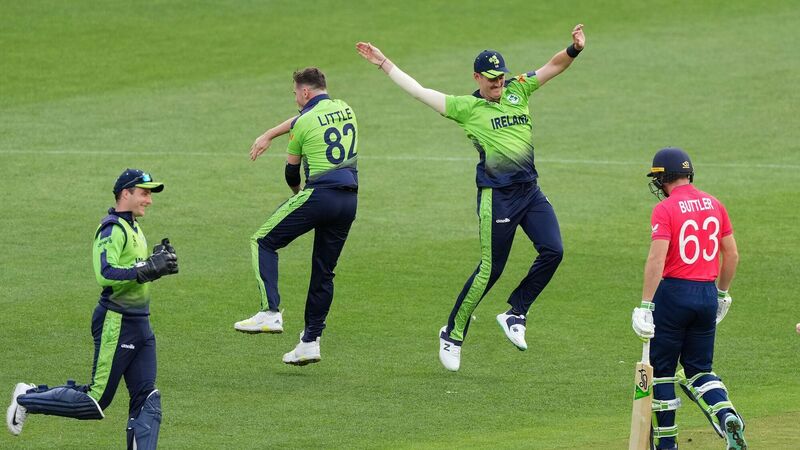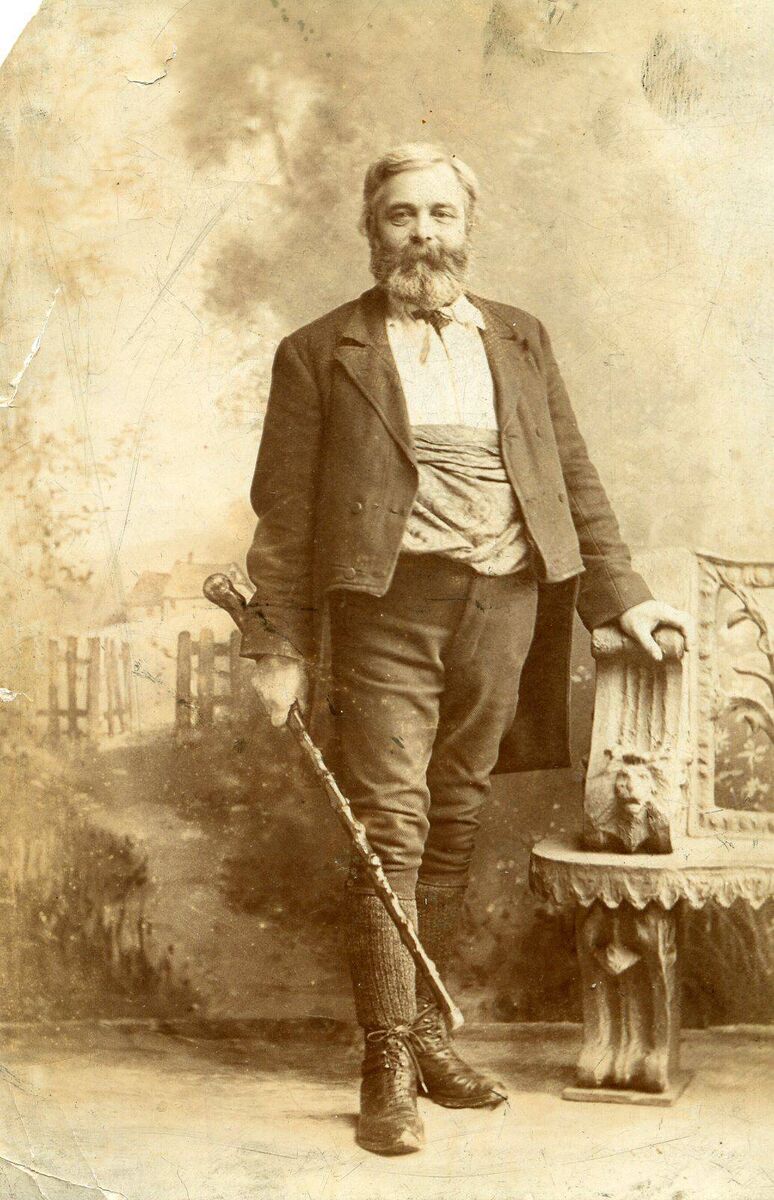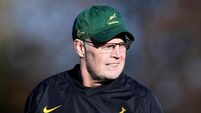Paul Rouse: Beating England at their own game a very long time in making

JUMPING FOR JOY: Ireland's Joshua Little reacts after dismissing England batsman Jos Buttler during the T20 World Cup Super 12 match at Melbourne Cricket Ground in Melbourne, Australia. Pic: Scott Barbour/PA Wire
There are sports that are immediately associated with national identity. In terms of English identity, cricket is the game.
The imagery of warm beer, balmy summer days, lush pasturage, and notions of imperturbable Englishness — the stiff upper lip — is given its greatest sporting airing through cricket.
Nobody has captured the idea of this imagined Englishness of cricket with quite the same brilliance as Neville Cardus did in his book English Cricket which was published in 1945.
Cricket, he wrote, is not merely a game, but an institution that sits at the very heart of English life. This institution “holds the mirror up to English nature”, and in it “we see the men, the originals, the characters, all sorts and conditions, in a cavalcade of English character that travels down the years”.
Cardus is esteemed as one of the greatest cricket writers of them all — if not the greatest. For him, the cricket field and its surrounds created a particular atmosphere and a way of life which was seared onto the nation’s consciousness.
More than anything, he believed that cricket offered a space where men (and he only wrote of men) could reveal themselves, while its phrases — such as “Play a straight bat!” and “It’s not cricket!” — assumed an almost liturgical significance in wider society.
That cricket was adopted by people across the empire meant that the game became associated which much more than just Englishness, however.
It became something special to Indians and Australians and South Africans. And in that something special, beating England assumed central importance.
The legacy of the spread of cricket across the British empire is such that it now stands as the second most popular game in the world — behind soccer and ahead of basketball.
And, of course, one of the places it is now played — and has become a way to beat the English at their own game is in Ireland.
The simple truth is that the beating of England this week is a very long time in the making.
Back in 1880 — before Michael Cusack and Maurice Davin had even conceived of the GAA — cricket was everywhere in Ireland. Put simply, it was the most important field game in Ireland. There were teams of cricketeers in every county; it was widespread across Irish schools and businesses and other establishments. There was even an annual publication — 'John Lawrence’s Handbook of Cricket in Ireland’ — which was published every year and included club records, fixture lists, match reports and historical accounts of the growth of cricket across Ireland.

So prosperous was cricket by the end of the 1870s, that the main nationalist newspaper in the country — the Freeman’s Journal — had no doubt as to its future: “At present, it is no exaggeration to say, cricket is known and played all over the island. We may take it for granted that the youth will establish it permanently.”
The enthusiasm for cricket demonstrated by the Freeman’s Journal was reiterated in The Irish Sportsman, a weekly newspaper dedicated to sport in Ireland. An editorial in that paper in 1875 considered that cricket “is one of the few English importations with which the most sincere ‘Nationalist’ cannot find any cause of quarrel, and in which all ranks and classes may meet on equal terms”.
It was also seen as a game in which Irish men could develop a talent to such a point where “we may be able to show John Bull we can beat him, or, at least, hold our own well against him in his national game”. Ultimately, cricket was something, the press said, that might be considered “a national pastime”.
Indeed, one of the people who proposed that should be the case was the founder of the GAA, Michael Cusack. The first record of Cusack playing cricket was when he went to work as a teacher in the French College in Blackrock in the summer of 1874.
The French College (later known simply as Blackrock College) had about 200 students at the time and Cusack was given a job teaching commercial subjects in the new department which the school was opening to prepare students for civil service and armed forces examinations. There is a record in the College accounts of Cusack buying a pair of specialized cricketing pants to play the game.
It is likely he had previously played for other teams in other places, but even if not, he soon became a keen cricketer. By the time he reached his mid-30s, Cusack was able to recall his involvement in “many a hard-fought match”.
His passion for the game was obvious. He referred to it on several occasions in a weekly column he wrote in the Dublin newspapers.
Cusack wrote once, for example, that it would help cricketers to pass away the dark days of winter, by dreaming of the wonderful six that they had hit in mid-summer, and of feeling pride at having walked to the crease, the forlorn hope of their parish, before saving the day with a memorable performance.
He wrote, also, of the advisability of setting up cricket clubs in every parish in Ireland. For Cusack this was not simply a matter of boys getting exercise to enhance their health — it was also a matter of character.
To this end, he wrote in July 1882: “You may be certain that the boy who can play cricket well, will not, in after years, lose his head and get flurried in the face of danger.”
This is language that was entirely in keeping with the words of the headmasters of the elite schools of Victorian England, of Harrow and Rugby, of Eton and Westminster.
As late as the autumn of 1882 Cusack was offering boys advice on how to clean a cricket bat using linseed oil and how to store it for the winter.
Of course, by the time that winter of 1882 had turned to the spring of 1883, cricket was gone from Cusack’s column — replaced, instead, by a plea for the revival of the game he termed Ireland’s ‘national pastime’ — the game of hurling.
How did this happen?
The political and social climate was obviously influential. The tumultuous events of the land war left the scent of social revolution hanging in the air.
On top of that, the gathering force of Parnellism suggested the genuine prospect of legislative independence for the first time in a generation. The strains in the union were becoming apparent and, in late 1882, it was entirely unclear what would next come to pass. After all, this was the year when the two most important British officials in Ireland had been murdered while strolling through the Phoenix Park in Dublin.
On a personal level, there are clues in the columns which Cusack wrote over these critical months, though no conclusive answers. He was clearly influenced by two non-political and non-sporting events in 1882. One was the Industrial Exhibition of Irish-made goods in Dublin, which suggested a new economic future for Ireland; the second was the groundbreaking launch of the Irish-language publication — Irisleabhar na Gaedhilge (the Gaelic Journal) by the Gaelic League, of which Cusack had become a central figure.
The third event was a sporting event — the establishment in December 1882 of a hurling club in Dublin.
These three events are mentioned in Cusack’s columns in February 1883 when he extols, for the first time the virtues of reviving hurling.
He never again wrote of the idea of spreading cricket or promoting it; instead, he devoted much of the rest of his life to hurling.
Part of this process involved cricket being denoted by the Gaelic Athletic Association as a “foreign game”. The antipathy of the GAA had an impact on the prosperity of cricket, but so too did other factors, including the failure of cricket itself to establish a proper governing body until well into the 20th century. By then, it had long lost it prominence.
That cricket is now thriving again in Ireland is, itself, testimony to the love which lives on in disparate communities. It is also the result of the professionalisation of the game by the governing body Cricket Ireland, more people playing the game through schools’ programmes and immigration, and the long slow march to achieving test status which was attained in 2017.
The question is: what happens next? Is there a ceiling beyond which cricket simply cannot grow in Ireland? Or has beating England changed the parameters of the possible?








